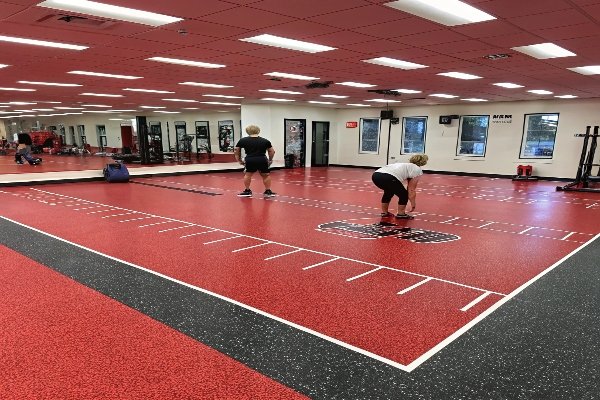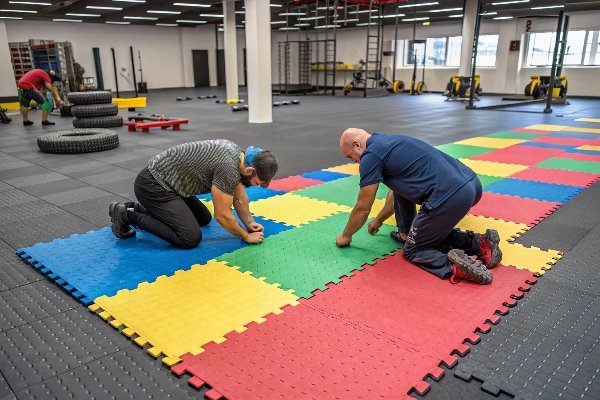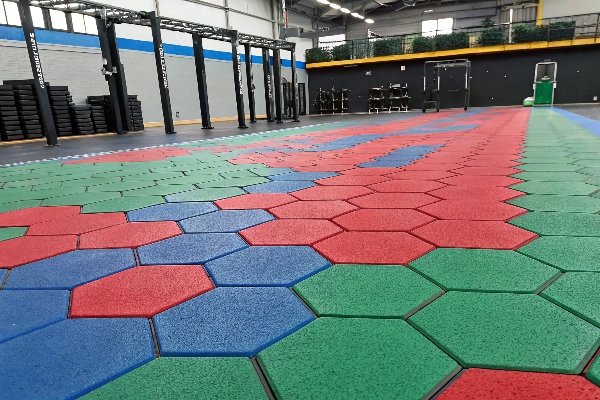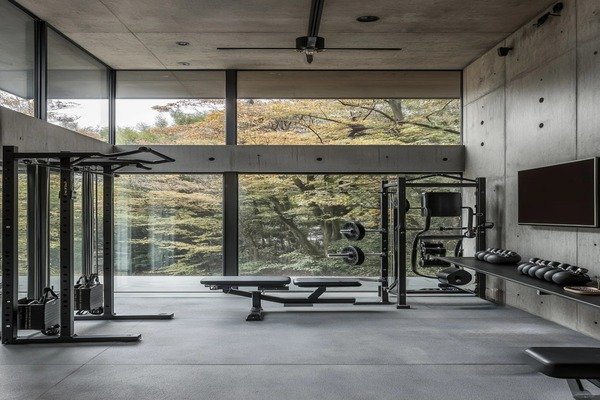Rubber gym flooring typically lasts 8-12 years depending on quality, usage, and maintenance. For high-traffic commercial gyms, expect 5-7 years of excellent performance, while properly maintained installations can serve 10-12 years. It’s absolutely ideal for busy fitness environments.
As a production manager at a rubber flooring factory for over 15 years, I’ve seen firsthand how our products perform in various environments. Rubber gym flooring has become the gold standard for fitness facilities worldwide, and for good reason. The durability factor alone makes it worth the investment, but there’s much more to consider when outfitting your gym with proper flooring. Whether you’re setting up a commercial fitness center or creating a home gym, understanding the lifespan and benefits of rubber flooring will help you make an informed decision.

What makes rubber flooring so special is its remarkable resilience under pressure. I’ve visited countless gyms that installed our rubber gym mats and floor tiles years ago, and they’re still going strong despite daily punishment from heavy weights, equipment, and constant foot traffic. Let’s dive deeper into what makes rubber flooring the preferred choice for fitness environments and how long you can expect it to last.
What is rubber gym flooring and how is it made?
Rubber gym flooring consists of either virgin rubber (from natural tree sap) or recycled rubber (primarily from vehicle tires), processed into resilient mats, tiles, or rolls. Manufacturing involves grinding rubber, adding binding agents and colorants, then compressing under heat to create durable, shock-absorbing workout surfaces.
The production process of rubber gym flooring is fascinating and directly impacts its durability. In our factory, we produce several types of rubber flooring for different gym applications:
Raw Materials and Processing
Most gym rubber flooring falls into two categories: virgin rubber and recycled rubber. Virgin rubber offers premium quality and consistency but comes at a higher price point. Recycled rubber gym flooring utilizes post-consumer waste (mostly tires) and transforms them into affordable, environmentally friendly gym floor mats and tiles.
The manufacturing process begins with grinding rubber into small particles. We then mix these with binding agents and colorants before compressing the mixture under extreme heat and pressure. This vulcanization process creates the tough, resilient gym matting that can withstand years of punishment from dropped weights and exercise equipment.

What’s remarkable about this material is how it maintains its structural integrity even after years of heavy use. I’ve personally visited fitness centers using our rubber gym flooring products for nearly a decade, and while they show signs of wear, they continue performing their essential functions of protection, shock absorption, and noise reduction.
Why is rubber flooring commonly used in high-traffic gyms?
Rubber flooring dominates high-traffic gyms because it absorbs impacts from heavy weights, provides excellent traction even when wet, dampens noise significantly, and protects expensive subfloors. Its durability under constant foot traffic and ability to withstand dropped barbells and dumbbells makes workout rubber mats essential for professional facilities.
When I consult with commercial gym owners about flooring options, I always emphasize rubber’s unique benefits for high-traffic environments:
Superior Impact Resistance and Floor Protection
Drop a 20-kilogram plate on concrete, and you’ll likely damage both the weight and the floor. Drop it on quality rubber gym floor mats, and both remain intact. This impact absorption is crucial in weight rooms and CrossFit boxes where equipment gets dropped regularly.
Noise Reduction Properties
Rubber gym floor tiles and mats dramatically reduce the noise from dropped weights and exercise equipment. In a multi-story building or shared commercial space, this noise dampening is invaluable. I’ve measured decibel reductions of up to 40% with our thicker rubber gym flooring products.
Safety Through Slip Resistance
Even when exposed to sweat or water, quality rubber gym flooring maintains its grip. This safety factor alone makes rubber gym floors worth the investment, as it significantly reduces liability from slip-and-fall accidents that plague fitness centers with less suitable flooring.

The combination of these benefits explains why nearly every major fitness chain invests in rubber gym flooring. From Planet Fitness to Gold’s Gym, the industry recognizes that proper gym flooring is not just about aesthetics—it’s a crucial operational investment that affects safety, maintenance costs, and member satisfaction.
What factors determine the lifespan of rubber gym flooring?
The lifespan of rubber gym flooring depends primarily on material thickness (15-25mm lasts longer), quality of rubber used, installation method, maintenance routine, equipment weight concentration, and traffic patterns. Higher quality gym matting with proper care can significantly outlast budget options.
In my years overseeing rubber flooring production, I’ve identified several critical factors that determine how long gym floor mats will last:
Thickness and Density
Thicker rubber gym flooring (15mm or greater) generally outlasts thinner options, especially in areas with heavy equipment. For commercial weight rooms, we recommend 15-25mm thickness, with areas supporting extremely heavy equipment benefiting from the full 25mm rubber gym floor mats for maximum protection and longevity.
Quality of Materials
Virgin rubber typically outlasts recycled rubber gym flooring, though high-quality recycled products can still perform admirably for years. The binding agents used also significantly impact longevity—our premium lines use advanced polymers that resist breakdown even under extreme conditions.
Installation Method
Properly installed gym flooring lasts significantly longer. Incorrect installation can lead to shifting, curling edges, and premature wear. Whether using interlocking gym mats or glue-down rubber gym floor tiles, professional installation often pays for itself through extended product life.

Another factor that gym owners often overlook is the importance of subfloor preparation. Even the best rubber gym flooring will deteriorate faster if installed over an uneven or moisture-prone substrate. I’ve seen cases where improper subfloor conditions cut the lifespan of premium rubber mats for gym use by more than half.
How long does rubber flooring typically last under heavy usage?
Under heavy commercial usage, quality rubber gym flooring typically lasts 5-7 years before showing significant wear. Premium workout floor mats in properly maintained facilities can extend to 10-12 years, while home gym flooring often lasts 12-15 years due to lower traffic and equipment loads.
The lifespan question is one I hear constantly from gym owners considering investing in rubber flooring. Based on our company’s extensive data and customer feedback:
Commercial Gym Applications
In high-volume commercial settings with constant foot traffic and heavy equipment use, expect:
- Economy rubber gym floors: 3-4 years
- Standard commercial-grade rubber gym flooring: 5-7 years
- Premium rubber gym floor mats: 8-12 years
Home Gym Applications
For home gym flooring, the numbers are much more favorable:
- Basic home gym floor mats: 8-10 years
- Premium home gym flooring: 12-15 years
The dramatic difference between commercial and home applications stems primarily from usage intensity. A commercial gym might see hundreds of users daily, while home gym flooring might only support 1-5 people several times weekly.

I recently visited a college weight room that had installed our premium 15mm rubber gym floor mats about 8 years ago. Despite daily use by student athletes, including Olympic lifters dropping substantial weights, the flooring showed only superficial wear while maintaining its structural integrity and protective qualities.
What maintenance practices can extend the life of rubber flooring?
To maximize rubber gym flooring lifespan, implement daily sweeping, weekly damp mopping with mild detergent, prompt spill cleanup, proper equipment mats under heavy machines, periodic deep cleaning, and immediate repair of damaged sections. Avoiding harsh chemicals and using proper cleaning techniques prevents premature deterioration.
Proper maintenance dramatically extends rubber flooring life. Here’s what I recommend to our customers:
Regular Cleaning Schedule
Establish a consistent cleaning regimen for your gym floor:
- Daily: Sweep or vacuum to remove abrasive particles
- Weekly: Damp mop with a pH-neutral cleaner specifically designed for rubber gym matting
- Monthly: Deep clean with appropriate rubber-safe cleaners to remove built-up residues
Equipment Protection
Place additional rubber mats for gym equipment under particularly heavy items like squat racks and weight stacks. These secondary workout floor mats distribute weight more effectively and protect the main gym rubber flooring from excessive compression and wear.
Preventative Measures
Train staff to immediately clean up spills, particularly protein shakes or sports drinks that can become sticky and attract dirt. Consider implementing a "no outdoor shoes" policy in areas with premium rubber gym floor tiles to reduce tracking in abrasive grit and contaminants.

I’ve seen firsthand how maintenance makes a difference. Two gyms installed identical rubber gym flooring from our factory—one implemented rigorous maintenance protocols while the other performed minimal upkeep. After five years, the well-maintained floor looked nearly new, while the neglected one required replacement sections and showed significant deterioration.
How does rubber flooring compare to other gym flooring materials?
Rubber gym flooring outperforms vinyl, carpet, and concrete in durability, impact absorption, and noise reduction for fitness environments. While hardwood offers aesthetic appeal for group exercise areas, rubber gym floor mats remain superior for weight rooms. Compared to foam mats, rubber provides significantly longer lifespan despite higher initial cost.
Having manufactured and supplied various flooring materials over my career, I can confidently compare the options:
Rubber vs. Vinyl/PVC
While vinyl offers lower upfront costs and easy cleaning, it simply cannot match rubber gym flooring’s impact resistance and durability. Vinyl typically lasts 3-5 years in gyms, compared to 5-12 for quality rubber gym floor mats.
Rubber vs. Foam
Foam exercise mats for home gym use cost less initially but require replacement far more frequently. Foam compresses permanently and tears under heavy equipment, while rubber gym flooring maintains its structure and resilience.
Rubber vs. Concrete/Hardwood
Bare concrete or hardwood offers virtually no protection for either subfloor or equipment and creates dangerous noise levels when weights are dropped. The addition of proper rubber gym flooring creates a safer, more user-friendly environment while preserving the underlying floor.

The most telling comparison comes from multi-purpose facilities. In one sports complex I consulted for, they initially installed different flooring types in different zones. Within three years, they had replaced everything except the rubber gym flooring with—you guessed it—more rubber flooring. The performance difference was simply too significant to ignore.
What types of rubber flooring are best for commercial gyms?
For commercial gyms, high-density vulcanized rubber flooring in 15-25mm thickness performs best. Interlocking gym tiles offer easy installation and replacement of damaged sections, while rolled rubber flooring provides fewer seams. Custom-cut rubber gym floor mats work well for specialized equipment areas with unique dimensions.
When consulting with commercial gym owners, I recommend specific rubber flooring configurations based on usage zones:
Weight Room/Free Weight Areas
For areas with heavy dumbbells and free weights, 20-25mm thick rubber gym floor mats or tiles are essential. This substantial thickness provides superior impact protection and longevity under extreme use, particularly where Olympic lifting or CrossFit activities occur.
Cardio Equipment Zones
For treadmills, ellipticals, and other cardio machines, 15-20mm rubber gym flooring rolls work exceptionally well. The continuous surface prevents equipment from shifting during use while providing adequate protection.
Group Exercise Rooms
For multi-purpose exercise rooms, interlocking gym mats in 15mm thickness offer versatility and easy reconfiguration when needed.

The installation method matters significantly for commercial applications. While DIY is possible with interlocking gym floor tiles, professional installation of glue-down rubber gym flooring ensures proper adhesion and seam treatment that can add years to the flooring’s usable life.
Can recycled rubber flooring be durable enough for busy fitness centers?
High-quality recycled rubber gym flooring can indeed withstand busy fitness center demands. Modern manufacturing processes transform tire rubber into durable workout floor mats that perform nearly as well as virgin rubber products. With proper thickness (minimum 15mm) and quality control, recycled rubber gym flooring lasts 5-8 years even in high-traffic facilities.
As someone who oversees production of both virgin and recycled rubber gym flooring, I can address this common concern:
Manufacturing Advances
The recycled rubber flooring industry has evolved dramatically. Today’s processing techniques remove contaminants and ensure consistent density and performance. Premium recycled rubber gym floor mats now approach virgin rubber in durability while offering significant cost savings.
Environmental Benefits
Beyond performance, recycled rubber gym flooring diverts thousands of tires from landfills. A typical 5,000 square foot gym floor using recycled rubber mats keeps approximately 5,000-7,000 tires out of landfills—a significant environmental benefit.
Performance Expectations
While virgin rubber still holds a slight edge in uniformity and appearance, recycled rubber gym floor mats perform remarkably well in real-world applications. In our durability testing, premium recycled products achieve 85-90% of the lifespan of virgin rubber under identical conditions.

One of our largest clients operates a chain of 24/7 fitness centers. After testing both virgin and recycled rubber gym flooring in different locations, they found the performance difference didn’t justify the cost premium for virgin material. They’ve standardized on our high-quality recycled rubber flooring for all new locations.
Why do gym owners choose rubber flooring despite the upfront cost?
Gym owners choose rubber flooring despite higher upfront costs because it delivers superior long-term value through reduced injury liability, lower equipment replacement costs, minimal maintenance requirements, and extended facility lifespan. The initial investment in quality gym rubber flooring typically pays for itself within 2-3 years through these operational savings.
The economics of rubber gym flooring make compelling sense when examined holistically:
Total Cost of Ownership
While rubber gym floor mats might cost 30-50% more than basic flooring initially, the extended lifespan and reduced maintenance needs result in a lower annual cost. My clients consistently report that quality rubber gym flooring is more economical over a 5+ year period.
Risk Mitigation
Properly installed rubber gym flooring significantly reduces slip-and-fall incidents. For commercial gyms, this liability reduction alone can justify the premium cost through lower insurance rates and avoided legal claims.
Equipment Preservation
Weights, machines, and other fitness equipment last longer when used on proper rubber gym floor mats. The savings on equipment replacement and maintenance often exceed the additional flooring cost within a few years.

I recently calculated the ROI for a fitness center that upgraded from economy vinyl to our premium rubber gym flooring. Between reduced equipment damage, lower maintenance costs, and member retention improvements (partially attributed to better flooring), they recouped their additional investment in just 18 months.
Conclusion
Rubber flooring stands as the ideal solution for high-traffic gyms, lasting 5-12 years in commercial settings and up to 15 years in home gyms with proper care. Its unmatched durability, safety features, and long-term value make it the smart choice for any serious fitness facility.
